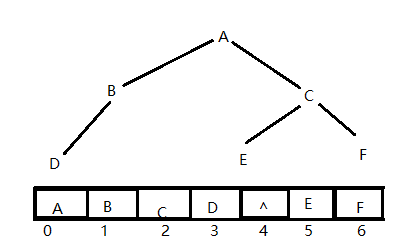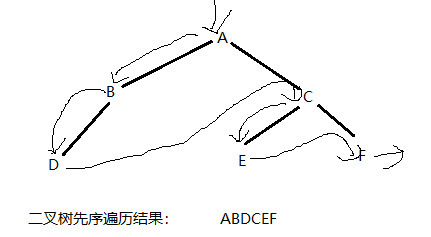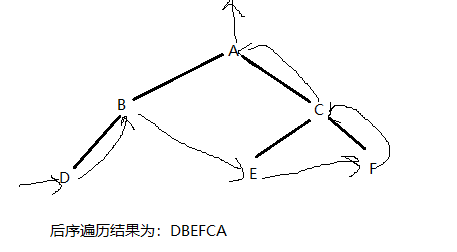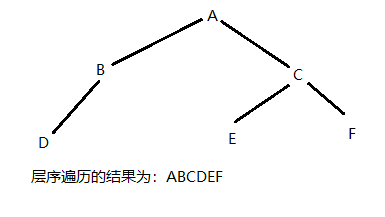一颗二叉树是一个节点的有限集合,是由一个根节点和两个子树构成;每个子树又有两个子树。这两个子树分为左子树和右子树,且顺序不能颠倒。如图,像一个倒着的树一样:
它有两种存储方式,一种是顺序存储,一种是链式存储。
顺序存储:
对于一棵完全二叉树所有结点按照层序自顶向下,同一层自左向右顺序存入一个顺序表中,如果该节点为空,则存入一个特殊的字符代表NULL。例如:
这就是二叉树的顺序存储。
优点:存储完全二叉树,简单省空间
缺点:存储一般二叉树尤其单支树,存储空间利用不高
链式存储:
二叉树的链式存储结构是用结构体定义结点,每个结点有两个指针,一个指向它的左子树,一个指向右子树。如图:
下面实现二叉树链式结构的基本操作:
定义结点:
typedef char DataType;
typedef struct TreeNode
{
DataType elem;
struct TreeNode* rchild;
struct TreeNode* lchild;
}TreeNode;
实现二叉树的初始化:
void InitTree(TreeNode** root)
{
assert(root);
if(*root == NULL)
return;
*root = NULL;
return;
}
实现二叉树的先序遍历:
算法:(递归版本)
若二叉树为空,算法结束;否则
a 访问根节点
b 先序遍历根节点的左子树
c 先序遍历根节点的右子树
void PreOrder(TreeNode* root)
{
if(root == NULL)
return;
printf("%c ", root->elem);
PreOrder(root->lchild);
PreOrder(root->rchild);
return;
}
实现非递归版本的先序遍历:
1.若根节点为空(空树,不需要遍历),直接返回;
2.否则,将根节点入栈;
3.判断栈是否为空,不为空进入循环;
4.取栈顶结点并访问该节点,同时将该节点出栈;
5.若该节点的右子树不为空,将右孩子结点入栈;
6.若该节点的左子树不为空,将左孩子节点入栈;
7.直到栈为空,跳出循环,完成了先序遍历。
void PreOrderByLoop(TreeNode* root)
{
if(root == NULL)
return;
SeqStack s;
InitSeqStack(&s);
PushSeqStack(&s, root);
TreeNode* tmp;
while(IsEmpty(&s) != 1)
{
TopSeqStack(&s, &tmp);
printf("%c ", tmp->elem);
PopSeqStack(&s);
if(tmp->rchild != NULL)
PushSeqStack(&s, tmp->rchild);
if(tmp->lchild != NULL)
PushSeqStack(&s, tmp->lchild);
}
return;
}
实现二叉树的中序遍历:
递归版本:
若二叉树为空,直接返回;否则
1.遍历二叉树的左子树
2.访问根节点
3.遍历二叉树的右子树
void InOrder(TreeNode* root)
{
if(root == NULL)
return;
InOrder(root->lchild);
printf("%c ", root->elem);
InOrder(root->rchild);
return;
}
非递归版本:
1.若树为空,直接返回;否则令tmp=root,进入循环(跳出条件为栈为空 或 tmp==NULL)
2.循环的将tmp节点的所有左子树入栈
3.取栈顶结点为tmp,访问该节点并出栈
4.令tmp=tmp的右孩子,进入下一次循环
void InOrderByLoop(TreeNode* root)
{
if(root == NULL)
return;
SeqStack s;
InitSeqStack(&s);
TreeNode* tmp = root;
while(IsEmpty(&s) != 1 || tmp != NULL)
{
while(tmp != NULL)
{
PushSeqStack(&s, tmp);
tmp = tmp->lchild;
}
TopSeqStack(&s, &tmp);
printf("%c ", tmp->elem);
tmp = tmp->rchild;
PopSeqStack(&s);
}
实现二叉树的后续遍历:
递归版本:
若树为空,直接返回;否则
1.遍历根节点的左子树;
2.遍历根节点的右子树;
3.访问根节点。
void PostOrder(TreeNode* root)
{
if(root == NULL)
return;
PostOrder(root->lchild);
PostOrder(root->rchild);
printf("%c ", root->elem);
return;
}
非递归版本:
1.若树为空,直接返回;否则令tmp= root,进入循环(条件为栈非空或tmp!=NULL)
2.循环的将所有左子树入栈;
3.去栈顶结点,若该节点没有右子树或者右子树已经访问过了,则访问该节点并出栈;
4.否则,令tmp为该节点的右子树,进入下一层循环。
void PostOrderByLoop(TreeNode* root)
{
if(root == NULL)
return;
TreeNode* tmp = root;
TreeNode* pre = NULL;
TreeNode* top;
SeqStack s;
InitSeqStack(&s);
while(IsEmpty(&s) != 1 || tmp != NULL)
{
while(tmp != NULL)
{
PushSeqStack(&s, tmp);
tmp = tmp->lchild;
}
TopSeqStack(&s, &top);
if(top->rchild == NULL || top->rchild == pre)
{
printf("%c ", top->elem);
pre = top;
PopSeqStack(&s);
}
else
tmp = top->rchild;
}
return;
}
实现二叉树的层序遍历:
1.若树为空,直接返回;
2.否则将根节点入队列;
3.取队首结点,访问该节点;
4.若该节点的左子树不为空,将左子树入队列;若右子树不为空,将右子树入队列;
5.循环的进行3和4,直到队列为空。
void LevelOrder(TreeNode* root)
{
if(root == NULL)
return;
SeqQueue q;
InitSeqQueue(&q);
PushSeqQueue(&q, root);
TreeNode* tmp;
while(SizeSeqQueue(&q) != 0)
{
FrontSeqQueue(&q, &tmp);
printf("%c ", tmp->elem);
if(tmp->lchild != NULL)
PushSeqQueue(&q, tmp->lchild);
if(tmp->rchild != NULL)
PushSeqQueue(&q, tmp->rchild);
PopSeqQueue(&q);
}
return;
}
二叉树前序遍历规则应用:二叉树的创建/拷贝
二叉树的创建:
现有一个带有特殊字符的二叉树先序遍历结果,其中特殊字符是代表空节点,如何建立这样的二叉树?
答:利用递归版本的先序遍历方法,构建还原该二叉树。
TreeNode* _CreateTree(DataType array[], size_t size, DataType null_node, size_t* index)
{
assert(index);
if(*index >= size)
return NULL;
if(array[*index] == null_node)
{
++*index;
return NULL;
}
TreeNode* new_node = CreateNode(array[(*index)++]);
new_node->lchild = _CreateTree(array, size, null_node, index);
new_node->rchild = _CreateTree(array, size, null_node, index);
return new_node;
}
TreeNode* CreateTree(DataType array[], size_t size, DataType null_node)
{
assert(array);
size_t index = 0;
return _CreateTree(array, size, null_node, &index);
}
二叉树的拷贝:
类似的:
TreeNode* TreeClone(TreeNode* root)
{
if(root == NULL)
return NULL;
TreeNode* new_node = CreateNode(root->elem);
new_node->lchild = TreeClone(root->lchild);
new_node->rchild = TreeClone(root->rchild);
return new_node;
}
二叉树后序遍历规则应用:二叉树的销毁
void DestroyNode(TreeNode* node)
{
free(node);
return;
}
void TreeDestroy(TreeNode** root)
{
assert(root);
if(*root ==NULL)
return;
TreeDestroy(&((*root)->lchild));
TreeDestroy(&((*root)->rchild));
DestroyNode(*root);
*root = NULL;
return;
}
求二叉树的高度 :
二叉树的高度为左子树和右子树高度较大的那一个!
size_t TreeHeight(TreeNode* root)
{
if(root == NULL)
return 0;
size_t lheight = TreeHeight(root->lchild) + 1;
size_t rheight = TreeHeight(root->rchild) + 1;
return rheight > lheight ? rheight : lheight;
}
求二叉树叶子结点的个数
叶子结点:没有左右孩子的结点;
二叉树叶子结点的个数 = 左子树叶子结点的个数 + 右子树叶子结点的个数。
size_t TreeLeafSize(TreeNode* root)
{
if(root == NULL)
return 0;
if(root->lchild == NULL && root->rchild == NULL)
return 1;
return TreeLeafSize(root->lchild) + TreeLeafSize(root->rchild);
}
求二叉树第K层结点的个数
size_t TreeKLevelSize(TreeNode* root, int K)
{
if(root == NULL)
return 0;
if(K == 1)
return 1;
return TreeKLevelSize(root->lchild, K-1) + TreeKLevelSize(root->rchild, K-1);
}
求二叉树的镜像
解决方法:递归的交换二叉树的左右子树。
void TreeMirror(TreeNode* root)
{
if(root == NULL)
return;
TreeNode* tmp = root->lchild;
root->lchild = root->rchild;
root->rchild = tmp;
TreeMirror(root->lchild);
TreeMirror(root->rchild);
return;
}
解决方法(二):(非递归)
遍历该二叉树,同时交换每个结点的左右子树。
以下是用层序遍历实现的:
void TreeMirrorByLoop(TreeNode* root)
{
if(root == NULL)
return;
SeqQueue q;
InitSeqQueue(&q);
PushSeqQueue(&q, root);
TreeNode* tmp;
while(SizeSeqQueue(&q) > 0)
{
FrontSeqQueue(&q, &tmp);
TreeNode* tp = tmp->lchild;
tmp->lchild = tmp->rchild;
tmp->rchild = tp;
if(tmp->lchild != NULL)
PushSeqQueue(&q, tmp->lchild);
if(tmp->rchild != NULL)
PushSeqQueue(&q, tmp->rchild);
PopSeqQueue(&q);
}
return;
}
判断一棵二叉树是否为完全二叉树(层序遍历变形)
问题分析:
若为完全二叉树,层序遍历每个结点,左右子树都存在,直到遍历到一个转折结点,若只有左子树或没有子树,那么接下来层序遍历的结点都没有子树。
问题解决:
1.将根节点入队列,并且置flag=0(代表不是完全二叉树);
2.进入循环(循环条件为队列非空);
3.取队首结点,并出队列
4.若flag==0
若该节点左右孩子都存在,分别入队列;
若该节点只有左孩子节点,入队列,并置flag=1;
若该节点只有右孩子结点,返回0(不是完全二叉树);
5.若flag==1
若该节点左右孩子都不存在,什么都不做;
否则,flag=0;
6.直到队列为空,跳出循环,返回flag。
int IsCompleteTree(TreeNode* root)
{
if(root == NULL)
return 1;
SeqQueue q;
int flag = 0; //表示该树不是完全二叉树
InitSeqQueue(&q);
PushSeqQueue(&q, root);
TreeNode* tmp = root;
while(FrontSeqQueue(&q, &tmp))
{
PopSeqQueue(&q);
if(flag == 0)
{
if(tmp->lchild != NULL && tmp->rchild != NULL)
{
PushSeqQueue(&q, tmp->lchild);
PushSeqQueue(&q, tmp->rchild);
}
else if(tmp->lchild == NULL && tmp->rchild != NULL)
return 0;
else if(tmp->lchild != NULL && tmp->rchild == NULL)
{
PushSeqQueue(&q, tmp->rchild);
flag = 1;
}
else
{
flag = 1;
}
}
else
{
if(tmp->lchild != NULL && tmp->rchild != NULL);
else
flag = 0;
}
}
return flag;
}






